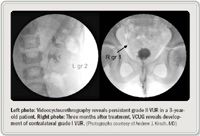Article
New contralateral VUR post-implant is not uncommon
San Francisco—New contralateral vesicoureteral reflux occurs more often than previously thought following endoscopic treatment of unilateral VUR and may warrant further treatment, according to a report presented at the American Academy of Pediatrics Section on Urology meeting here.

Fifteen of 95 children developed new contralateral VUR following endoscopic implantation of dextranomer/hyaluronic acid copolymer (Deflux, Q-Med, Uppsala, Sweden) for VUR. The incidence approaches the 20% rate of contralateral VUR observed in some series of open correction of unilateral VUR.
The unexpected finding of cases of new contralateral reflux following endoscopic treatment raises questions about which patients require treatment.

Contralateral VUR in 20% New contralateral VUR has been reported in up to 20% of patients following open correction of unilateral VUR, Dr. Kirsch and colleagues noted in their poster presentation. The etiology remains unclear, but it might be secondary to distortion of the trigone or likely a pop-off mechanism.
To determine the incidence of new contralateral VUR following unilateral endoscopic implantation procedures, investigators reviewed results in 95 children who underwent the procedure between October 2001 and March 2004. The age of the study population averaged 4.5 years (range, 7 months to 15 years).
The copolymer was injected submucosally within the intramural ureter (hydrodistention implantation technique) in most cases. At 3 months, patients were evaluated by cystourethrography for the presence of VUR. The imaging studies revealed new contralateral VUR in 15 children (16%). The new contralateral VUR was grade I in seven cases, grade II in seven, and grade III in one case. The patients were all girls who had no history of voiding dysfunction.
The 16% incidence of new contralateral VUR was unexpected, Dr. Kirsch said, given the presumption that endoscopic procedures are less frequently associated with the complication. Although mild in most cases, the contralateral VUR resulted in additional therapy for patients and families that had sought to avoid antibiotic prophylaxis or further surgery.
Dr. Kirsch, an associate clinical professor of urology at Emory University, has developed a grading system to predict whether a patient will develop contralateral reflux (see Urology Times, August 1, 2004,).
"The grading system involves hydrodistention of the ureter," he said. "If the ureter pops open and we can see up the ureter, we can grade the classification on the basis of how much of the orifice opens in response to the pressure flow. So far, patients who develop contralateral new reflux have ureters that will open so you can directly visualize the entire ureteric tunnel (grade 2) or the extravesical ureter (grade 3)."
Dr. Kirsch has organized a prospective clinical trial to evaluate the grading system. Patients with unilateral reflux will be treated on only one side, and investigators will use findings from hydrodistention of the contralateral side to predict which patients will develop contralateral reflux.
In Dr. Kirsch's most recent analysis of 190 patients, a total of 10% developed new contralateral reflux. Girls younger than 5 years of age were at the highest risk (16.8%). The risk was not increased by the initial reflux grade or whether treatment was offered after initial diagnosis (one VCUG) or after several years of persistent unilateral reflux (two or more VCUGs).
"If the new dynamic hydrodistention grading system-coupled with age and gender of the patient-is able to predict an increased risk for the development of new contralateral reflux, it would be prudent and justified to treat such patients in a bilateral fashion," Dr. Kirsch said.




